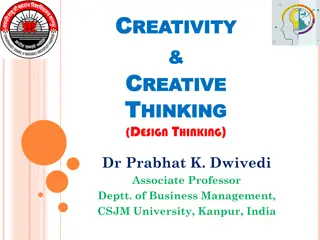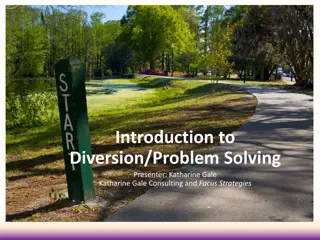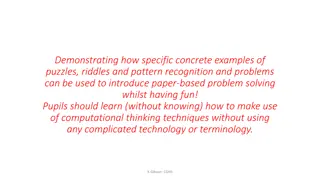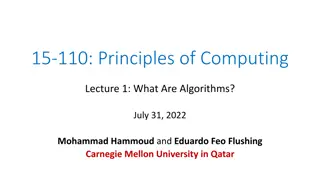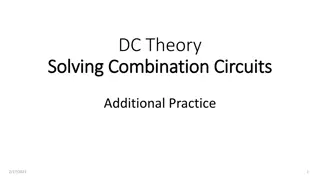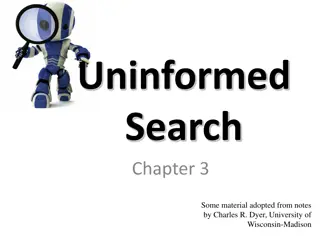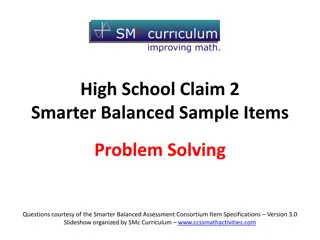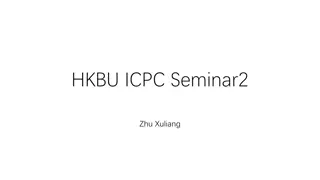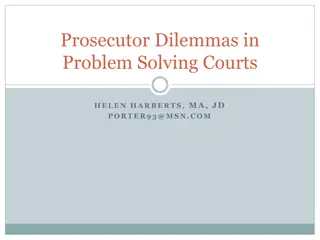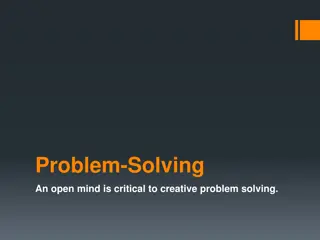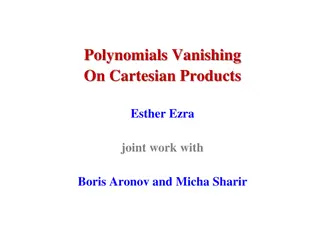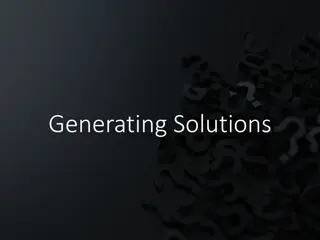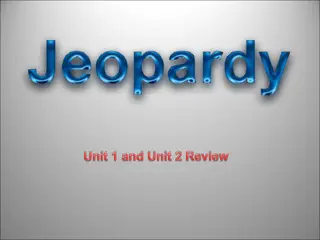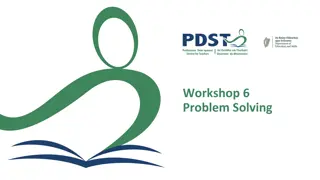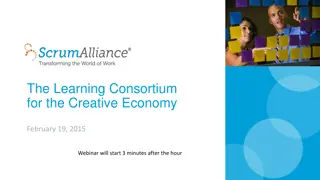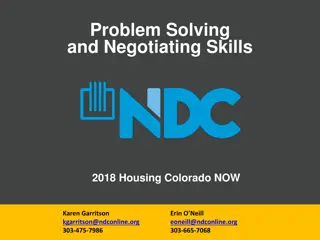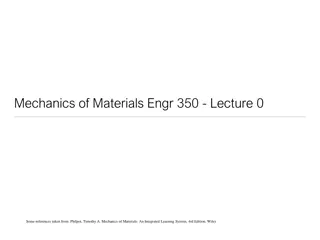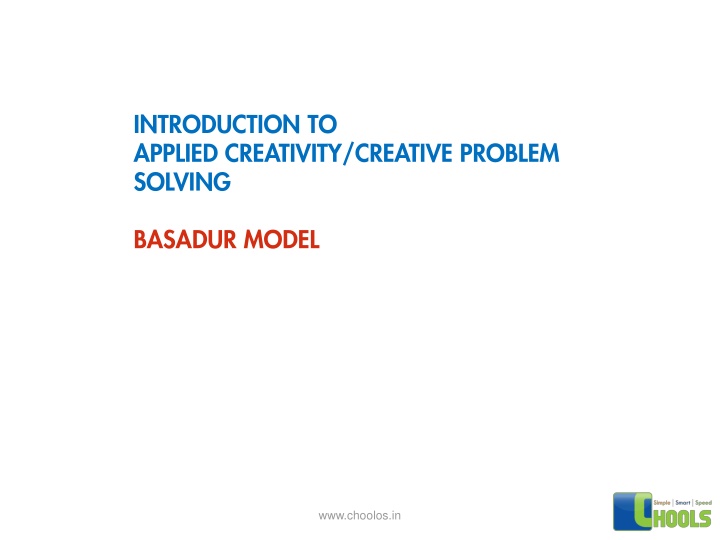
Mastering Creative Problem Solving with Basadur Model & Innovation Fundamentals
Dive into the world of creative problem-solving using the Basadur Model. Learn how to combine analytical thinking and creativity to generate innovative solutions. Explore the 10 innovation fundamentals that will guide you in separating content from process, diverging from converging, and deferring judgment. Unleash your creativity by understanding the essence of separate diverge and converge processes. Avoid killer phrases during divergence and embrace a dynamic approach to problem-solving. Let's embark on a journey to enhance your problem-solving skills creatively!
Download Presentation

Please find below an Image/Link to download the presentation.
The content on the website is provided AS IS for your information and personal use only. It may not be sold, licensed, or shared on other websites without obtaining consent from the author. If you encounter any issues during the download, it is possible that the publisher has removed the file from their server.
You are allowed to download the files provided on this website for personal or commercial use, subject to the condition that they are used lawfully. All files are the property of their respective owners.
The content on the website is provided AS IS for your information and personal use only. It may not be sold, licensed, or shared on other websites without obtaining consent from the author.
E N D
Presentation Transcript
INTRODUCTION TO APPLIED CREATIVITY/CREATIVE PROBLEM SOLVING BASADUR MODEL www.choolos.in
CREATING INNOVATIVE SOLUTIONS Creating innovative solutions requires a combination of the following: Analytical thinking Creativity Analytical Thinking Harder to harness but tools exist to help us The statistical tools of Lean Six Sigma work here www.choolos.in
10 INNOVATION FUNDAMENTALS 1. One conversation at a time 2. Use simple decoded language 3. Differentiate content from process 4. Separate diverge from converge 5. Defer judgement 6. Clarify where you are in the process 7. Quantify first, quality later 8. Build on each others ideas 9. Encourage wild ideas 10. Relax and have some fun! www.choolos.in
WHAT IS CREATIVE PROBLEM SOLVING? Creative Problem Solving involves the use of creative thinking to develop innovative solutions to complex problems www.choolos.in
SEPARATING CONTENT AND PROCESS Problem owner (client): The What of the problem; This is the person who is hurting , and the person who has to make it happen ; Content Role Participant: Also a Content Role; Helping the owner, selected on What they can contribute in knowledge, originality, etc. Facilitator: Is a Process Role; Concerned with the How the group is going to work together to attack the problem. Coach: A team member chosen by the facilitator to give feedback at the end of the meeting www.choolos.in
SEPARATE DIVERGE AND CONVERGE CONVERGE DIVERGE EVALUATE IDEATE Yes Judgment Yes logic Narrow -Quality -Judgmental -Disciplined -Intellect -Adult No Judgment No logic Widen -Quantity -Imaginative -Free -Gut -Child 2 1 DEFERRAL OF JUDGMENT The process skill of withholding judgement to allow divergent thinking. Keeps divergent and convergent thinking separate. www.choolos.in
KILLER PHRASES DURING DIVERGENCE A good idea, but Against company policy. All right in theory, but Costs too much Not budgeted Not our problem Let s discuss We ve never done it that way It s not part of my job The client won t go for it Let s make a survey first It s not good enough Ahead of times Let s form a committee Who else have tried it? Why hasn t someone suggested it before if it s such a good idea? OUCH! No killer phrases please! .Can you think of more? www.choolos.in
DECODE TRIBAL LANGUAGE HUH? Decode tribal language please! Make communication easier spell it out! IQN SAP SOP CIC LOL LMK NTH GTH GTKY GTKM WIIFM WIIFU CCI BCI QA IT www.choolos.in
Applied Creativity Applied Creativity Creative Problem Solving Creative Problem Solving BASADUR Model Find Problem Act Gain Accept ance Find Facts Formulate Problem/ Opportunity Implement Solution Define Problem Plan Find Ideas Evaluate & Select Formulate Solution www.choolos.in
A. FORMULATE PROBLEM/OPPORTUNITY Problem Finding DIVERGE: Use Divergent Thinking. List problems, goals, opportunities, challenges, wishes, dreams, and other fuzzy situations that you sense you might like to try doing something about. CONVERGE: Go back and select one of the above problems as your fuzzy situation 1. a. b. www.choolos.in
CHECKLIST OF QUESTIONS TO HELP IDEATE TO FIND PROBLEMS Individual problem finding How might you like to improve? What has bothered you recently? What risks and uncertainties do you face now? What are the bottlenecks? What would make you happy? Organizational: Sensing the present What minor problems could grow into big ones? What turf issues are hindering progress? What issues and problems require good teamwork between? What more could be done to improve quality? Organizational: Anticipating the Future What changes, issues, problems, and opportunities for improvement do you visualize two years down the road? What information would you like to get in advance to make your job a lot simpler? What new issues will be raised by others if you don t do it first? What will be your customers biggest challenges over the next year? www.choolos.in
A. FORMULATE PROBLEM/OPPORTUNITY Fact Finding DIVERGE: List as many simple, clear answers to the following fact finding questions as possible. Defer judgment. Go for quantity. Think of WHO, WHAT, WHERE, WHEN, HOW, WHY, etc. CONVERGE: Go back and select the most intriguing facts, gaps, revelations, etc. 2. a. b. www.choolos.in
KEY FACT FINDING QUESTIONS What do you know or think you know about this fuzzy situation? What don t you know that you d like to know . Why is this a problem for you? What have you already done? If this problem is solved, what would you have that you don t have today? What might you be assuming that you don t need to assume? 1. 2. 3. 4. 5. 6. www.choolos.in
A. FORMULATE PROBLEM/OPPORTUNITY Problem Definition 3. INITIAL DIVERGENCE: Deferring judgment, list as many creative challenges as you can based on these facts. Use your imagination! Start each challenge by saying HOW MIGHT I.. a. INITIAL CONVERGENCE: Select one challenge (or more than one if you have time) that seems most pertinent. b. www.choolos.in
A. FORMULATE PROBLEM/OPPORTUNITY Problem Definition 3. FINAL DIVERGENCE: Perform a Why What s Stopping analysis using your selection as a beginning point. Make a challenge map below c. Why? Why would it help you to ? How Might I What s stopping? Is it that you have not yet ? d. FINAL CONVERGENCE: Select one best challenge from above. Take this single best creative challenge to the next step. www.choolos.in
B. FORMULATE SOLUTION Idea Finding Write the challenge that you selected How might I . Idea Finding Techniques 4. Un-clumping Building on wildest idea The TRANSFORM Principle a. DIVERGE: Now generate ideas which might solve this problem as defined above. Defer judgment! b. CONVERGE: Select the best ideas and write in the grid www.choolos.in
BUILDING ON THE WILDEST IDEA ALASKA www.choolos.in
BUILDING ON THE WILDEST IDEA ALASKA ICE www.choolos.in
BUILDING ON THE WILDEST IDEA ALASKA www.choolos.in
BUILDING ON THE WILDEST IDEA ALASKA www.choolos.in
KEY QUESTIONS ON DIVERGENCE 1. 2. 3. 4. 5. What do you know or think you know about this situation? What don t you know that you d like to know . Why is this a problem for you? What have you already done? If this problem is solved, what would you have that you don t have today? What might you be assuming that you don t need to assume? 6. www.choolos.in
B. FORMULATE SOLUTION Evaluation and Selection a. DIVERGE: List all possible criteria which might be relevant to judging the ideas selected from step 4 5. b. CONVERGE: Select the most relevant criteria and write in the grid. Evaluate the ideas against criteria. Rate each on a 1 to 4 scale. ideas Excellent 4 3 2 1 Poor www.choolos.in
C. IMPLEMENT SOLUTION Plan Write your selected solution a. DIVERGE: First, list answers to the following two questions: 6. What new problems might this solution create? a. How might this solution be introduced? b. b. DIVERGE: Second, list answers to the following question: What specific steps might I take to get the ball rolling to implement this solution? www.choolos.in
C. IMPLEMENT SOLUTION CONVERGE: Action Plan Write the steps you will take first in the What column of the action plan below, then fill in the How , Who (you), Where for this step. There is space for additional steps. c. What How Who When Where 1 2 3 4 www.choolos.in
CREATIVE PROBLEM SOLVING STEPS Gaining Acceptance 7. Write a plan for selling your solution. Whom do I need to convince of it s value? What problem of his/hers will this solution help solve? List the benefits to him/her of this solution List the possible objections to this solution How might you prove each benefit? How might each objection be overcome? www.choolos.in
CREATIVE PROBLEM SOLVING STEPS 8. Action! Now it s all up to you! You need to take the actions indicated in step 6 and 7. If you don t, nothing will happen. If you do, you will accomplish something valuable, develop yourself, and experience incomparable AHA! Feeling! www.choolos.in
EXAMPLES Sample Pre-work Planning Sample CPS workshop report www.choolos.in

